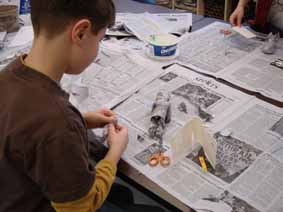







Art Ties Into Other Subjects | Art Promotes Development | Art Helps Create Experiences | Down to Bottom
Art Ties Into Other Subjects
A second grader's Egyptian profile portrait. |
Art is a very broad and flexible subject. All art projects in Ms. Showalter's art class will include some kind of history or culture lesson. Students may explore the art of a particular country or people, or they may study a particular artist or period in history. Art also often ties into mathematics, especially geometry. Students at the elementary level are also taught how to use rulers to measure their paper and practice drawing straight lines. Older students, mainly in 4th and 5th grades, are also encouraged to share ideas, opinions, and criticisms about the art we view in class, as well as evaluate their own. Fourth and fifth graders are required to write brief reflections about their art on their personal evaluation sheets at the end of each project. |
Art Promotes Development
Art class is an excellent opportunity for younger students to practice their fine motor skills. Manipulating tools such as pencils, erasers, crayons, and paintbrushes are wonderful exercise for hand/eye coordination. Older students are challenged to paint and draw as neatly as possible. Younger students may strengthen their hands by cutting and tearing paper. Clay also is especially beneficial for small hands.

A first grade girl works on her Australian Aborigine Painting.
Art Helps Create Experiences
In every art class I attempt to allow my students to use as many materials as possible in our brief time together. Students are given the opportunity to use 2-dimensional mediums such as paint, pencils, oil pastels and pastels, 3-dimensional materials such as clay and papier mache, and tactile materials such as yarn and collage. Students engage in problem solving in every project. As their piece develops they have to make a wide range of decisions about how they will achieve their desired outcome. Some decisions are purely aesthetic, such as figuring out the size and color of a particular element in a piece. Other decisions are more technical, such as how to improve their observational drawing abilities or how to complete a sculpture. Art allows students to participate in creative decision making.

A fourth grader must use found objects and make creative decisions to create a work of art in papier mache.
Art Ties Into Other Subjects | Art Promotes Development | Art Helps Create Experiences | Back to Top
Questions? Please e-mail Sarah Showalter at: sesfh3@mizzou.edu
This site was last updated on July 14th, 2005.
